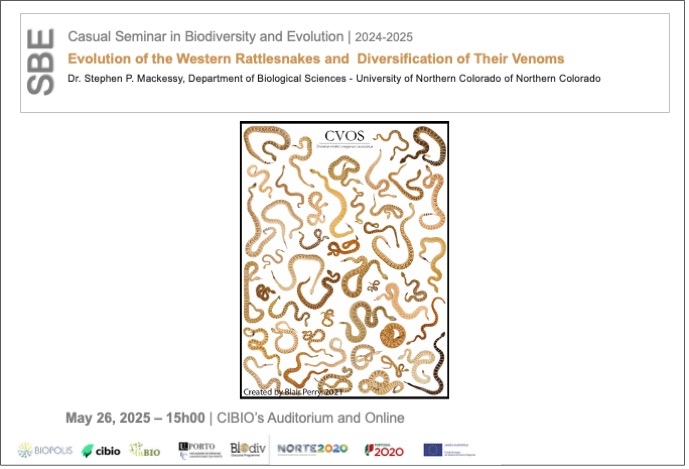Evolution of the Western Rattlesnakes and Diversification of Their Venoms
26 Jun 2025 - Dr. Stephen P. Mackessy, Department of Biological Sciences - University of Northern Colorado of Northern Colorado | 15h00 | Hybrid Seminar

CASUAL SEMINAR IN BIODIVERSITY AND EVOLUTION
The Western Rattlesnake clade consists of several species, including C. cerberus, C. viridis, C. oreganus and C. scutulatus (hereafter CVOS), with combined ranges that span the western half of the United States, extending into south-central Mexico and SW Canada. The taxonomy of the group has been contentious and debated for some time, and understanding regional differentiation is complicated by numerous cases of range expansion/contraction, secondary contact and introgression in many areas, and current isolation due to geographic features. However, these same factors have produced a natural experiment scenario for evaluating their effects on venom phenotypes on a broad geographic scale. Over many years, we have collected venom samples broadly, focusing on specific taxa and then assembling this data into a larger cohesive group in order to identify trends that may occur among members of the CVOS clade. Ontogenetic variation in venom composition is common but is neither universal nor identical, and venom paedomorphosis appears to be limited to C. o. concolor and perhaps C. scutulatus, both of which are characterized by type II venoms (high toxicity, low SVMP activity) as adults. Most taxa produce venoms as adults with of a type I pattern (lower toxicity, higher proteolytic activities), though geographic trends are variable; Crotalus v. viridis, for example, shows disjunct compositional changes along a N-S axis, whereas C. cerberus venoms vary along an E-W axis, with greatest differences seen at extremes of distribution. Crotalus scutulatus shows an interesting pattern of type II (more common) or type I venoms, with several areas where "blended” venom phenotypes occur; venom type may be related to climatic variables. For C. v. viridis, these differences are likely associated with differential diets (more diverse in south) and several environmental parameters; for C. cerberus, insufficient diet data exists, but differences may be associated with edge-of-range effects.
Stephen P. Mackessy is Professor of Biology at the University of Northern Colorado. His B.A. and M.A. in Biology (Ecology/Evolution section) are from UC Santa Barbara, Dept. of Biology, and his Ph.D. (minor in Biochemistry) is from Washington State University, Dept. of Zoology. He was a postdoc at Colorado State University, Dept. of Biochemistry/Molecular Biology. His research encompasses the biology of venomous snakes and the biochemistry of snake venoms, and he has published over 200 scientific papers and book chapters, and several books. Mackessy has had 9 PhD, 24 Masters, and 67 undergraduate research students, and collaborations include colleagues from Singapore, Spain, México, Costa Rica, Argentina, Brazil, France, Germany, India, the Netherlands, the UK and University of Texas. Mackessy teaches graduate and undergraduate courses in biomedicine (Toxinology, Topics in Biomedical Research, Parasitology, Human Anatomy) and vertebrate biology (Herpetology, Comparative Anatomy, Mammalogy) at UNC, where he has received awards for outstanding research and teaching. Personal interests include fieldwork with venomous snakes, music and motorcycles, as well as traveling and camping.
[Host: Miguel Carretero, Functional Biodiversity - FBIO]
Zoom Link: https://videoconf-colibri.zoom.us/j/92460432768
Zoom Link: https://videoconf-colibri.zoom.us/j/92460432768